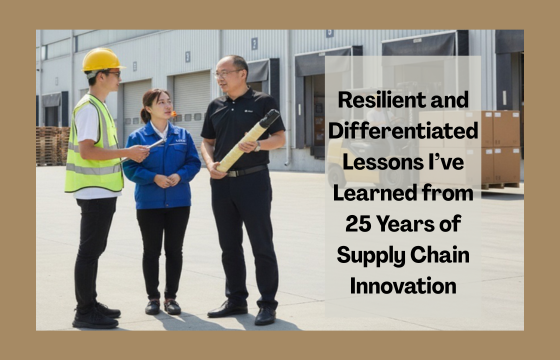Feeling Disrupted? There’s More Ahead

Feeling Disrupted? There’s More Ahead
When I get a chance to talk to the document imaging channel—the industry that makes, sells and services copy machines and printers all over the world—I always start out with a quote from a gentleman who was born in the late 1400s.
In 1513, Niccolò Machiavelli said this: “there’s nothing harder to take in hand, more perilous to conduct, more uncertain in its success than to take the lead with the introduction of a new order of things.
For the innovator has enemies: those who have done well under the old conditions, and lukewarm defenders in those who may do well under the new.”
The last part must be emphasised because it’s so important for my friends in the imaging channel space: “For the innovator has enemies those who have done well under the old conditions, and lukewarm defenders in those who may do well under the new.”
It’s those lukewarm defenders that really impede the innovation of an industry in disruption.
Over the last year, we’ve seen the world, in this pandemic shift to a remote workforce. When that shift happened, for the very first time in our industry’s history, our customers became aware that print equipment isn’t quite as important as they thought it might have been.
And it’s in that awareness that sparks innovation. Not only innovation from within but innovation from without.
Any time your customers decide to take a different path, the industry has to be on that path with them or they will, in fact, collapse.
The Automobile and the Horse
 The automobile was invented in the late 1800s. It took a long time to get that automobile up and running and going before it was filling up the streets.
The automobile was invented in the late 1800s. It took a long time to get that automobile up and running and going before it was filling up the streets.
But you know what? What if this happened? Imagine, if you will with me, that in the early 1900s, there was a horse pandemic and all the horses had to be quarantined. And despite all the horses that had to be quarantined the people still had to get from point A to point B. But they didn’t have the horse anymore. The automobile was there. Maybe they were procrastinating over that automobile. Maybe they didn’t have the money to buy that automobile. But they’re forced into it. They got to do it. They buy the automobile.
And let’s just say a year later, the pandemic for the horses is over and all the horses are released from the barns. Do we honestly believe, that the people that got the car are going to trade that car in and get back on their horse?
Ladies and gentlemen, that’s where our industry is today.
Our users, for the very first time, have gotten an awareness—not that they don’t need to print as much—but an awareness that there are other ways to do business without printing the page. Think about that.
How many applications have been moved to the cloud? How many people are moving documents between each other and keeping them behind glass? More and more. Feeling Disrupted? There’s More Ahead
A4 Revolution
We talk about workflows in our industries. You know what? The biggest disruption to workflow is simple. It’s to have to stop and scan something or print it. That’s a disruption to workflow. People try to eliminate disruptions.
I’m not saying that we’re never going to print anymore. I’m not saying that you’re not going to put supplies in those printers. But what I’m saying is this: the volumes are going to decline. They’re going to decline massively. Not only are the volumes going to decline, but the way we deliver the equipment to the end-user is going to change and it’s going to change drastically.
There are whole industries out there built around delivering the big A3 copy machines to end-users. A whole industry. We call it the BTA-style channel.
Delivering A3 devices to end-users in offices, where the offices are closed, or the offices aren’t going to have as many people, is probably not a reality in the very, very near future.
But the A4 MFP is. There should be tremendous growth in the A4 MFP. That’s why I started the A4 revolution with my friends at Lexmark in Boston in 2018.
As I looked at the data in 2018, I saw the massive declines that are already happening—as I realized there were millions of A3 devices in the marketplace that were producing volumes of less than 5,000 pages a month. I know we are really overselling this commodity as an industry.
And the end-users would soon be aware that they don’t need to be oversold and they would buy an A4. Well guess what: that A4 revolution is on fire. Everybody’s talking about A4. They’re talking about A4 because they realize just like the end-users that the future of A3 isn’t really promising.
There are still some manufacturers out there that continue to talk about how they’re going to disrupt a $55 billion, A3 industry. I think that’s a delusion. The consolidation of the manufacturers has to happen. Feeling disrupted? There’s more ahead.
Work from Home
 When it comes to working from home, the remote worker is making a big impact which is making our industry appear to be totally insane from the outsiders looking in.
When it comes to working from home, the remote worker is making a big impact which is making our industry appear to be totally insane from the outsiders looking in.
Let me clarify. People have had printers in their houses for decades; since the printer was invented. Maybe it took a few years before we put them in our houses, but printers have been in people’s houses for a long, long time. People have been printing in their houses for a long, long time.
But people don’t print a lot in their houses. Sure, there are some “one-offs” with kids at home printing all kinds of stuff but that’ll change too.
Look at the workflows. Look at the person in their home that’s working for a company and ask yourself what are they printing and why are they printing it?
Do we really believe that this pandemic crisis caused these workers all this anguish: sitting in their home offices and scratching their heads asking, “I wish I could print, I wish I had a better color MFP. Oh, I need to scan all these documents.” They’re not saying that because they haven’t been saying that for the last decade, at least.
The work from home movement is nothing new. In 2017, I wrote about it in an article titled “Don’t Let Amazon Have All the Fun.” I was warning my friends that if you deliver equipment to businesses all over the world that you better start talking to those businesses and asking those businesses what their strategy is for the remote worker of the future. I wish a lot of them would have taken that advice because here we are in a global pandemic and the remote worker is a massive reality.
I was talking to a couple of executives of manufacturing companies, and they were trying to focus and try to figure out how many people were going to stay home versus how many people were going to stay in the office. Folks, that’s not the argument our channel needs to have. That’s not the argument it’s going to determine how we’re going to sell or what we’re going to sell.
The argument we need to be paying attention to is: if an organization puts 5% of their people at home, or if an organization puts 90% of their people at home, what the organization is going to do, it’s going to change its processes to accommodate remote workers. It’s not about their home. It’s about a remote workforce.
What’s the first thing that has to go away with a remote workforce? Well, one of the first things: is having the need to have to print off documents.
If you’re remote, your remote. I want to pick up my smartphone and move documents from it to the person I’m talking to on his smartphone. That’s what it’s about, folks.
Hey, Bill, Sam or Betty. We’re having a conversation. I want to send my information to you. In the old days, I would say, “Here’s my proposal.” Now the new day conversation goes like this: “I’ll text it to you. I’ll email it to you. Do you want it as a PDF? You want me to put it in Dropbox?”
Ladies and gentlemen, we can move documents in the digital landscape. We don’t need to print them.
So, let’s talk about the work from home and where the opportunity is because there is an opportunity because I just said people have been printing at home forever. People have printers in their houses.
The opportunity is going to be the manufacturer that could deliver a printer to somebody’s house cheaper than somebody else. I hate to say that word “cheaper,” but that’s the reality.
Do you honestly believe that people are sitting at home? Going through specs of printers like they are with their car? Like they are with a refrigerator? It’s a printer. They all do the same thing for the most part. Some of them are in that place, some of them are printers, some of them are black and white, some of them are color. Feeling disrupted? There’s more ahead.
The Problem with Analysts
Ladies and gentlemen, our industry believes we’re a lot more complicated to the end-user than the end-user realizes. That’s always a problem: that misalignment, that misalignment and aspirations between the product and the customer can be detrimental to any industry.
The difference between an analyst and a visionary is simple. The analysts: well they look at the past and they try to project the past in the future. And a visionary looks at the future and what they see in the future, they try to deliver to the present.
That’s the difference. We see a whole lot of analysts out there projecting. Do you remember it was predicted managed print services will become a $50 billion business? And the number kept going up. It was purely insane.
All these analysts talked about managed print services in the year 2025. I’m sure all those analysts right now are refiguring out the number. I’m sure all those analysts are starting to realize that in 2025 it probably won’t be called managed print services. It’ll probably be called digital workflow services. Who knows? But it’s not going to be about counting pages that are printed. It’s going to be about information moving around in a digital landscape.
Those are tough things to say to an industry that manufactures printers and its supplies and its parts. However, we have to start waking up to the realities of the market around us.
Why are we investing and doubling down and try to throw a bunch of apps onto devices, particularly A3 copiers? Think about it. We’re trying to build relationships with products where customers are only using those products until they don’t need to use them anymore. They’re not using them because it’s fun. They’re not going to the office, gathering around the water cooler talking about how they can’t wait to get to the A3 MFP in the hallway because there’s a new app on it. “Man, I don’t know about you guys, but I got to get out there. That machine’s always got people in front of it. And I’m trying to use the new fancy app. I haven’t been able to do it yet.”
Folks, that “shit ain’t happening.” It’s not. Regardless of what the manufacturers think, they need to pay attention to the realities of their customers and start building products around those realities.
Why aren’t we doubling down and making A4 even lower cost to service and support? It’s already much lower than the A3. Let’s make it lower. Let’s make it easier for the end-user to just buy one of those things, get it delivered to their house, pull it out of the box, put it on a shelf, have it automatically connect to their network. Oh, that already exists. Do you see what I’m saying?
We’re making things to try to save things, instead of creating things to try to reinvent things.
And that’s a big difference. That’s the first sign that an industry is in trouble. When they keep trying to save the past. Feeling disrupted? There’s more ahead.
Living in a Digital World
I talked about the horse and the automobile. Now think about this analogy: we’ve all heard the story about Blockbuster video stores and Netflix online streaming movie service. Remember the Netflix guys beating Blockbuster. And Blockbuster’s sitting there saying to themselves and to Netflix, “We don’t think that subscription model works. No one wants to do that. They want to come into the store; they want to get some popcorn from our popcorn machine; they want to talk to their neighbors. They are never going to buy into that subscription model.”
Could you imagine … could you imagine if you could go back in time and right after that conversation happened? There was a global pandemic and all of a sudden everybody was stuck in their house. All the Blockbuster stores have to close because nobody was really going to there because they were all stuck in their homes. Do you think that they would have picked the phone up and called up Netflix and say, “hey… about that subscription thing you were talking about …maybe that’s not a bad idea.”
Ladies and gentlemen, we’ve got to start thinking about all the good ideas that have come from this pandemic.
Then we got to start thinking about all the threats to all the industries that this pandemic caused.
When Sears and Kmart got together—the two big retailer giants in the US that were not doing really well on their own. There’s nothing worse than two dysfunctional organizations coming together to create one big dysfunctional organization.
When Sears and Kmart came together, I penned this quote, “a company becomes obsolete when they focus on delivering the past to the future instead of delivering the future to the present”.
Wouldn’t it have made more sense for Sears to buy a software company and figure out how to amplify a digital presence? I believe wholeheartedly that customer experience—for no matter what industry you’re in or what product you deliver—is found at the intersection between the digital and physical world. That’s where customer experience lives.
Our industry, or the automobile or any other industry, has to figure out how they can navigate between that digital and physical world properly. How does the print industry navigate inside that intersection between that digital and physical world? What products do they bring to market to help end-users have a better experience from the experiences they’re getting today?
Do you know what innovators look for? They look for all the things the old ways do it wrong. That’s what they do. They say, “Wow, that is a really bad way to do things. We could do that so much better.” Once they prescribe the prescription for doing it better, they set out on a path to educate the customer on that better way and they take away all these great relationships that status quo companies hung on to. They took advantage of. And they deliver those customers a better experience. That’s what innovators do. They always do that. Feeling disrupted? There’s more ahead.
Lukewarm Leaders are in Trouble
Elon Musk, the Tesla Automotive, the battery car guy, says, “Some people don’t like change, but you need to embrace change if the alternative is a disaster.”
The first thing we have to do is accept that if we don’t do anything, we’re headed for disaster. The next thing we have to do is accept that we have to change.
But here’s the problem. I don’t believe going forward, no matter what business you’re in, in the world we live in today, change management has to be replaced with what I call modification management.
If change management comes too late, it’s a reaction. It’s a reaction to something you didn’t do. Modification management is a continuous process.
Think about it this way: change management is surgery after the heart attack; modification management is eating the right foods, doing the right exercises, preventing the heart attack from ever even happening.
Niccolò Machiavelli also said this. He said the princes of his day did not lose their power through misfortune. “The princes [of his day] lost their power through indecisiveness and inaction. It will take decisive action to move from near obsolescence to continuous relevance.”
It will take bold action to move from near obsolescence to continued relevance.
Bold leadership cannot happen with lukewarm defenders of innovation. Those lukewarm defenders are sitting on the sidelines, hiding under their desk, afraid to speak up, afraid to challenge the status quo, hoping that the tenure of yesterday hangs around a little bit longer. We have to get those people out of the way. It’s sad but true. And as this industry starts to consolidate, the pain of that consolidation will be tremendous for the lukewarm. Man, the lukewarm: they’re in trouble. Those who have done well under the old conditions, they’re going to find out that they’d better start figuring out how to modify to the new conditions because the new conditions are coming, regardless of how much we want to keep current circumstances alive. The new way is coming.
But manufacturers out there when they buy each other up or they merge with each other, they got to even change it beyond that. Feeling disrupted? There’s more ahead.
Mergers and Acquisitions
I have talked about how Konica and Xerox should come together. I was the guy that said stood up and gave the argument at the 2017 RemaxWorld Summit in Zhuhai, that HP should go buy Xerox.
I have no idea what exactly HP is thinking and what they have been thinking—but they didn’t do that. Xerox actually went after them. That was a very bullish move and I thought Xerox was on the right track. Now, obviously, that’s not going to happen, but Xerox is not going to go away.
Xerox is a marketing company that sells, services and supports equipment, for the most part, that’s manufactured by others. It had an agreement with Fuji. We all remember that. It only makes its production equipment. A lot of people are not aware of it and think Xerox is a copier manufacturer. It’s not. It’s a manufacturer of a part of its product deliverable. But the majority of the machines that are in the field that Xerox services, supports and supplies are made by others.
So what does Xerox get from Konica? They get a manufacturer and they don’t have to buy Konica. Maybe they just partner with them in kind of the format they did with Fuji. Why don’t they just partner with them? They get the equipment they need to deliver into the marketplace. They get all of that Konica direct footprint that now becomes a Xerox direct footprint. Xerox becomes the marketing arm for Konica if you will.
This is a good example of what we have to start thinking about. Some have asked me, “What makes you think that a Japanese company is going to sell to an American company?” My answer is, “Well, a global pandemic that has caused a massive 20% reduction in revenue makes for strange bedfellows.”
Regardless of which sector you’re from, if you believe that nothing’s going to change, you’re nuts.
There will be tremendous amounts of changes. And you can’t go back to the way it used to be or think about why things didn’t work. You have to start thinking about how things will work. It’s so easy to think about how things won’t work. Feeling disrupted? There’s more ahead.
Crazy Thinking
When I started the A4 revolution with my friends at Lexmark in Boston in 2018, I was out there preaching to the world, “Stop over-speculating and over-selling A3. Customers don’t need those big giant devices.” I was looking at data realizing that there were millions of A3 copier machines across the world that were running less than 5,000 pages a month. That’s a perfect recipe for a disaster. It was ripe for an outside innovator to come in and snatch all those great relationships and deliver those customers with a better experience: an A4 experience.
I would get bombarded—from executives, from salespeople—with all the reasons why this wouldn’t work. They would talk about how salespeople work commission right to be able to sell A4; how manufacturers couldn’t just get rid of all that revenue if they switched from A3 to A4 because the A4’s are cheaper. Guess what, they just lost 20% to 30% of their revenue. Maybe they should have switched earlier.
We don’t have control over holding back relevance. Nobody does. Progress always wins. Any time you try to hold back relevance, you end up in obsolescence. That’s where you end up. We need to start thinking about what could happen based on why it should happen. And when we start thinking that way, we get creative.
When we start thinking about how Xerox and Konica come together profitably hitting home runs all over the park, it’ll spark imaginations. It’s easy to sit there and write down all the reasons it won’t work. It’s easy to hire some analysts to go out there and ask questions to get the answers to insinuate that wouldn’t work. That’s what a lot of these analysts are doing.
The Home Office is an Escape from Print Management
I look at some of the reports I see out there and I want to cringe. I saw a report recently from good analysts—I’m not trying to make fun of the analysts. I’m just trying to tell you that analysts at the end of the day, for the most part, aren’t visionaries. They’re not. They try to figure out how we’re going to do what we’re doing now in the future. They’re not trying to figure out what the future is doing and helping us bring that to the present.
But when I see articles written about how if a company pays for the worker’s device in their home, they’ll print more. Do you realize how silly that sounds? Come on, folks. A company that pays for the device in the person’s house will cause the worker to print more. What does that even mean? How does anyone come up with that conclusion? People are going to print what they need to print, whether it’s in their house or whether it’s in the job. They’re not just going to make stuff up to print.
Nor are people going to put DCA tools on their home printers. It’s not going to happen. Mom and dad are not going to sit around the kitchen table with pie charts and start yelling at the kids on what they printed at home. And how come they’re printing on mum or dad’s printer. They’re printing coloring book pages: they shouldn’t be doing that. They’re only allowed to print on Saturday, Betty can only print on Sunday. Do you think that’s going to happen? If you do, You’re nuts. It’s not. People are going to print at home like they have for the last fifteen years and they’re going to buy toner and inks when they need it.
The opportunity for those dealers that sell equipment to offices is to go to those offices and come up with programs that allow those workers to buy sub-$200 to $300 printers in a digital platform so they can get them delivered to their house. They could be set up without anybody interfering with them and they could supply toner when they need it.
Folks, it’s not about dragging print management to the future of the home office. The home office is like the escape of print management. Not to mention that print management wasn’t very successful in the SMB space since its birth 20 years ago. Print management was designed for the enterprise space. The enterprise space, folks. That’s where it was designed for. Today, if you look inside the imaging channel—that dealer space, those BTA style dealers that sell and service copy machines to customers all over the world—for every machine that’s on a contract, there’s between five and seven that aren’t. If you look at those DCA tools, you’ll see it. They’re all there.
The only problem is those dealers that have the one that’s contracted isn’t supplying or selling any of them. They’re buying supplies from Amazon and from office products resellers.
It’s good for the industry to sell supplies. It’s good for the industry that manufactures equipment. However, it’s not good for those resellers that sell business to business. So, the industry is going to have some shifts in the dynamics of its distribution. As more and more of these manufacturers start coming together, and as more and more of these manufacturers start looking outside the borders of the industry itself and bring in other folks into play with them.
We have got to be prepared. We have to learn how to modify along the way so that when the disruption really hits us hard, we’re ready. We can react, we can respond. We need to be looking outside of our own borders.
If you’re a parts provider for our industry, start thinking about how that looks in the future with fewer manufacturers. There could be some huge opportunities there as a matter of fact. If you’re a supplier making supplies—I said this back in 2017—I made a comment that the remans and new-builds were arguing with each other in the customer’s parking lot, the OEMs were going to go in those customers offices to take away the business. What they’re doing, that’s what they’re doing. They’re trying to take away the business. We’ve seen some of the things that HP has done by lowering their prices.
I wouldn’t be surprised if the OEMs start going to some new-build companies to make their OEM toner. I wouldn’t be surprised if the OEMs go to companies like Clover and ask them to be their remanufacturing arm. Folks, there has to be a lot of consolidation. There have to be massive changes in order to survive in order to stay relevant.
I want you all to think about the horse pandemic. Think about all these things that your end-users got exposed to and trust me they don’t want to run back they don’t want to run from progress. They want to run towards it.
Think about the Netflix-Blockbuster conversation. If the pandemic would have happened right after that, would Blockbuster have called back and said, oh yeah, we got to get into the subscription model?
There’s a lot coming our way. With bold fearless leadership, we can prevail. We can succeed. We can change the game.
I will remind you, as I always do as I wind up, that status quo is the killer of all that will be invented. Don’t get stuck in the status quo.
Have you found this article, “Feeling Disrupted? There’s More Ahead” helpful? You can also watch this presentation which was presented live via video hookup at the RemaxWorld Summit in November 2020 in China.
Ray Stasieczko is a forward-thinking and often controversial writer and speaker. You may not want to agree with everything he says, but you are compelled to read and listen. To do otherwise could spell doom.
He has called the imaging channel home for nearly 30 years and served in various roles and has contributed nearly 100 articles to the industry’s publications. Ray has also spoken at the RT Media Summits in Cairo, South America and China. You can contact him and watch him on LinkedIn.
Read Ray’s other blogs:
- Feeling Disrupted? There’s More Ahead
- ‘Five Years From Now’ Showed Up Early
- Meeting Standards Means Staying Relevant
- Thankfully My Doctor Wrote a Prescription Not My Obituary
- Business Opportunities Offered by this Pandemic
- That’s a Lot of Toner For a Market in Decline
- The Toner Wars Between Cartridge Suppliers
- When Will HP Write the Check to Xerox?
- The Imaging Channel is Not Alone in Needing Diversification
- Making Your Printer Consumables Business Profitable
- Are Acquisitions the Feel-good Drug in a Declining Market?
- Recognizing Disruption as a Creator and not a Competitor
- Managed Print Services is Not the Door to Managed IT Services
Comment:
Please add your comments below about this article, “Feeling Disrupted? There’s More Ahead” or join the conversation on LinkedIn.







Leave a Comment
Want to join the discussion?Feel free to contribute!